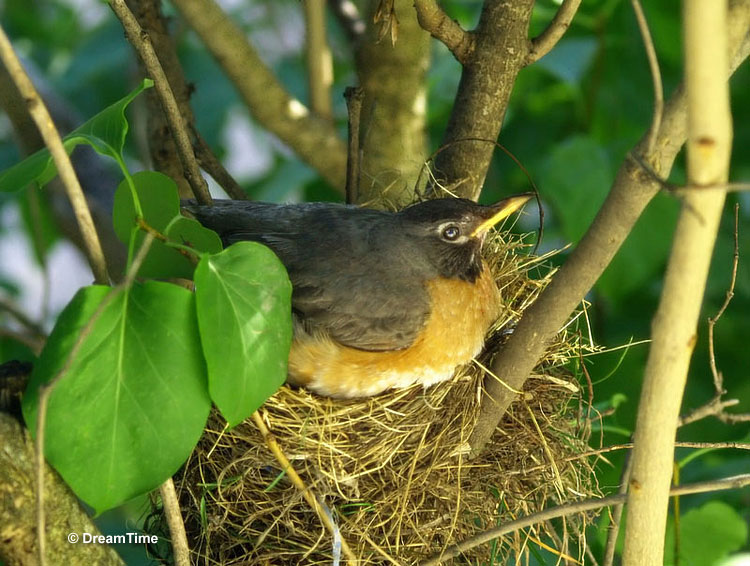The American Robin is a relatively large songbird. They have fairly long tails, round bodies, and long legs. American Robins are the largest thrush in North America. They’re a great bird to study when learning the basic shape of thrushes.
American Robins are commonly seen foraging for earthworms on lawns across North America. These birds are very popular due to their early appearance at the end of winter, cheery song, and warm orange breast.
Even though these birds are common sights in towns and cities, they inhabit wilder areas as well. This includes the Alaskan wilderness and mountain forests.
On this page
Breeding Male
American Robins have dark heads, warm orange underparts, and are gray-brown overall. A white patch under the tail and on the lower belly is easily visible in flight.
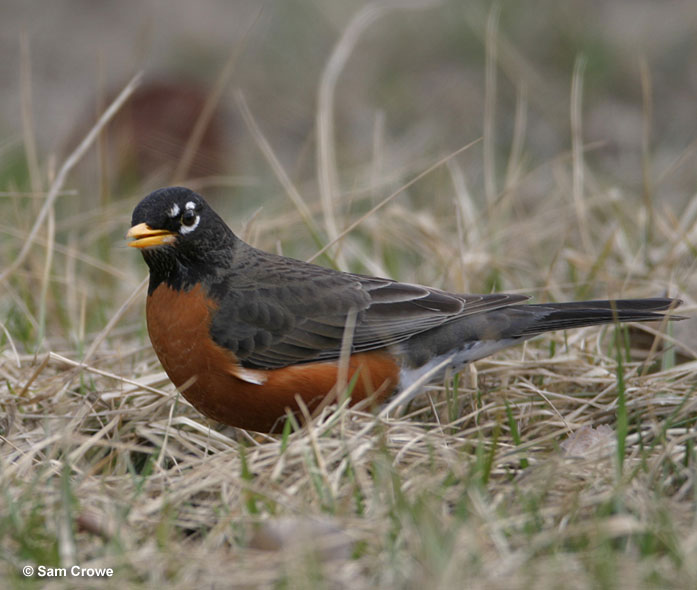
These birds are 7.9 to 11.0 inches (20 to 28 centimeters) long and weigh 2.7 to 3.0 ounces (77 to 85 grams).
See more: Birds that look like robins
Interestingly, these birds are commonly used to reference the size and shape of other birds. American Robins are about half as big as a bluebird.
Female
Female American Robins look very similar to male American Robins. However, females have paler heads. Their lighter heads contrast less with the gray back. They’re roughly the same size as males.
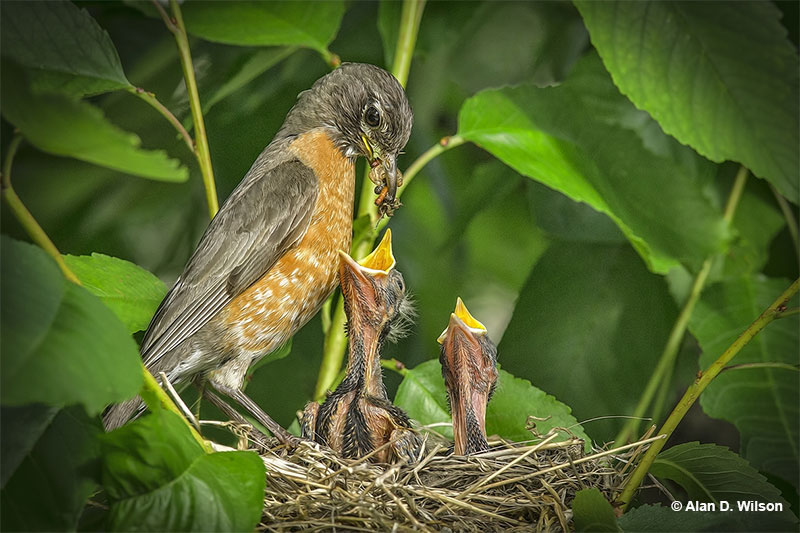
© Alan D. Wilson
Juvenile
Juvenile American Robins have pale heads, pale breast feathers, and mottled brown markings. The distinctive warm orange breasts and bellies will start showing through at this age.
Keep reading: Robin nest & eggs (ID guide + stages)
It takes 12 to 14 days for them to hatch. Then, it takes around 2 weeks for hatchlings to leave the nest, and they’ll stay with their parents for 2 to 3 weeks afterward. The father will continue to feed the juveniles while the mother starts incubating a new brood of eggs.
Habitat
American Robins are common across almost all of North America. You’ll find them in city parks, on fields, and lawns. However, they also inhabit more wild areas like forests, woodlands, tundra, recently burned forests, and mountains up to near treeline.
During the winter months, many American Robins move to moisture-laden woods where berry-producing shrubs and trees are plentiful.
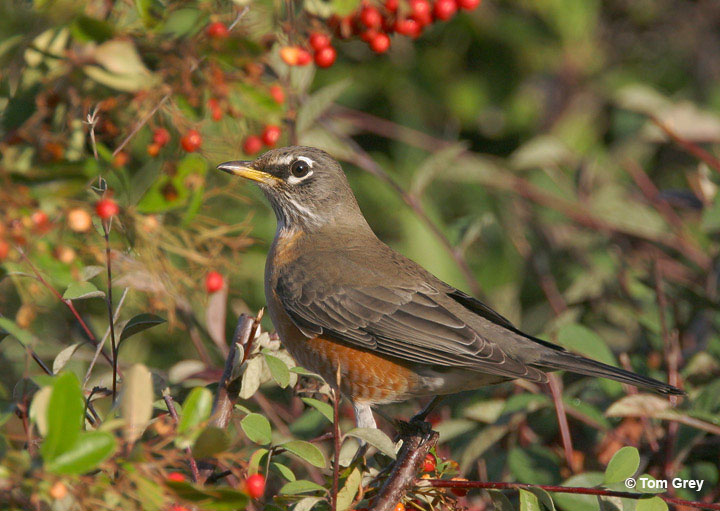
© Tom Grey
Diet
The American Robins diet mainly consists of fruit and invertebrates. In the spring and summer, These birds eat large numbers of insects, snails, and earthworms.
Ornithologists have recorded that they’ve eaten small snakes, aquatic insects, and shrews, but this is rare. American Robins also eat a wide variety of fruits like hawthorn, chokecherries, sumac fruits, juniper berries, and dogwood.
Behavior
American Robins commonly forage on the ground; you’ll see them run a few steps and abruptly stop. If they’re around tall grass, they’ll fly just above the ground powered by powerful, slow wingbeats or hop.

American Robin. Photo by Neil Soderstrom.
Their go-to food is earthworms, and they’ll find them by standing motionless and staring at the ground with their heads cocked to one side. During the fall and winter months, American Robins spend more time in trees and roost in large flocks during the fall and winter months.
Related: Common songbirds in the U.S.
In the spring, male American Robins attract female American Robins by shaking their wings, raising and spreading their tails, inflating their white-striped throats, and singing.
Range (and seasonal changes)
American Robins are short-distance migrants and year-round residents. Robins can inhabit almost anywhere south of Canada year-round.
Birds that breed in the northern slope of Alaska and Canada will leave in the fall for most of the U.S. Some American Robins will winter as far south as the Southwest United States, the Gulf Coast, and Mexico.
Wing shape
American Robins have pointed wings. This shape is typical for migratory birds. Their wingspan ranges from 12.2 to 15.8 inches (31 to 40 centimeters).
Fun Facts
- American Robins symbolize community, family, living in the moment, spring, leaving the past behind, rejuvenation, joy through song/music, fresh starts, gratitude, and abundance.
- The oldest recorded wild American Robin lived to be 13 years and 11 months old. This is very impressive since the average life span of American Robins is 1 year and 2 months. However, there have been many that lived to be about five or six years old.
- Believe it or not, American Robins sometimes get drunk. This is because they will flock to fermented berries. If these fermented berries are ingested in large quantities, the birds can get “drunk” and exhibit interesting behaviors like falling over while walking.
- Europe has its own robin called the European Robin. They are similar to American Robins, although they are not closely related.
- American Robins have a sweet tooth! Their favorite foods are sweet cakes, berries, fruits, and even pastry dough!
- American Robins symbolize good things – good luck, happiness, and rebirth
Call
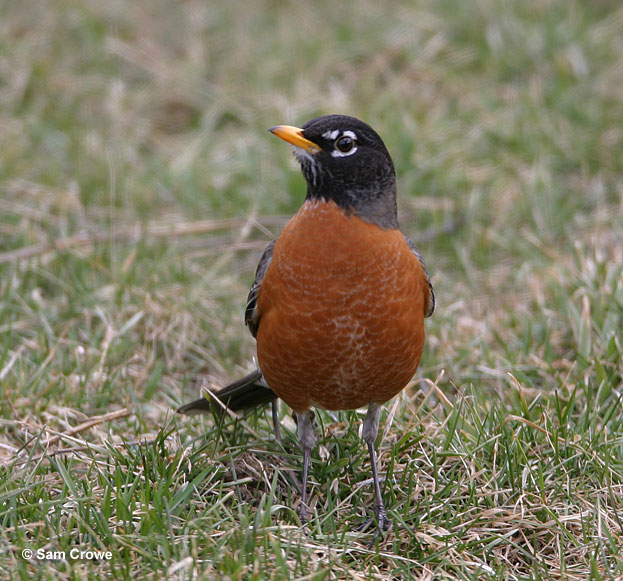
The American Robins musical call is associated with spring. It’s a string of clear whistles, around 10 of them, created from a couple of syllables that are often repeated. People say it sounds like “cheerily, cheer up, cheer up, cheerily, cheer up.” It rises and falls in pitch, but it’s carried out in a steady rhythm. There’s a pause before the Robin starts singing again. The song is more rapid at dawn.
American Robins often make a mumbled tuk or cuck to communicate with other Robins. They also make a sharp peek or yeep when alarmed.
They’ve also been heard making a repeated chirr that can sound like a chuckle or laugh that rises in volume. Female American Robins will aggressively clack their bill if an intruder approaches while she’s at the nest.
Similar Species
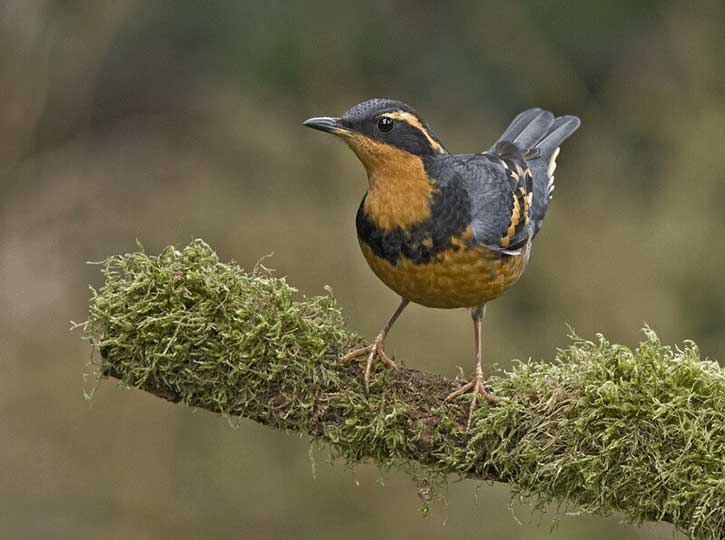
Varied Thrush © Alan Wilson
Similarly to American Robins, Varied Thrushes have orange plumage with some grayish and black highlights. However, it’s easy to navigate between the two. Varied Thrushes have contrasting black and orange plumage, while American Robins have more gray in their plumage.
Varied Thrushes also have orange speckles on their wings. Meanwhile, American Robins have gray wings.
Female Varied Thrushes look similar to American Robins too, but they are a bit more brownish than their male counterparts.
Both bird species are around the same size. American Robins have a much bigger range, and they inhabit most of North America. Varied Thrushes are only common in the western side of North America.
Frequently Asked Questions
What is unique about the American Robin?
American Robins are unique due to their early appearance at the end of winter, cheery song, and warm orange breast.
Are American Robins actually robins?
No, American Robins are not actually Robins. In fact, they’re a thrush! They got their name from early colonial settlers who named it after their breast color.
Are American Robins friendly?
Yes, American Robins are relatively friendly birds. They are naturally attracted to human-populated areas. Lawns provide them with an abundance of foods like earthworms. Additionally, your home provides them with a safe place to nest.
Where do American Robins live?
American Robins live in city parks, on fields, and lawns. They also inhabit more wild areas like forests, woodlands, tundra, recently burned forests, and mountains up to near treeline.

